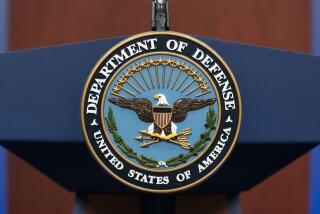U.S. Ready to Call Up Reserves : Mobilization: Army, Navy and Air Force want 150,000 for support work. Notices may go out next week. Civilian airlines ordered to provide up to 38 aircraft.
- Share via
KENNEBUNKPORT, Me. — President Bush is preparing to act on a Pentagon request for permission to call up as many as 150,000 members of the National Guard and other reserve units to meet critical shortages of support troops that are developing as a result of the massive U.S. military deployment in the Persian Gulf, sources said Friday.
White House officials said no final decision has been made on exact numbers, but they left little doubt that a substantial mobilization of reserves is imminent--with the first wave of call-up notices expected to go out as soon as early next week.
Indeed, Pentagon officials said, the armed forces cannot sustain the current buildup in Saudi Arabia--now approaching 50,000 troops and growing rapidly--without a heavy infusion of reserves.
The Army has sought approval for mobilizing 80,000 reservists, while the Navy and Air Force are seeking approximately 35,000 each, sources said. Secretary of Defense Dick Cheney is supporting the services’ requests and is understood to have discussed the need for a major call-up with Bush when the President made a speech at the Pentagon last Wednesday.
In a related move, the Pentagon ordered 16 civilian airlines to provide up to 38 aircraft for an indefinite period to help shuttle troops and equipment to the Middle East in the first-ever deployment under the Civil Reserve Air Fleet program.
The airlines have been asked to provide the planes and the crews needed to operate them within 24 hours.
Any large-scale mobilization of reserves--with its disruptive impact on lives of individuals, families and communities--is politically sensitive. As a result, Bush may elect to start with a relatively modest call-up, sources indicated, perhaps beginning with only a few thousand.
But Pentagon officials said that far larger numbers are needed and that they expect to get a substantial proportion of what they are requesting.
“Anything less than tens of thousands of reservists would be meaningless,” said one Army official. Not all of those called up are expected to go to the Middle East; some are likely to be used at bases in the United States and other countries as replacements for troops used directly in the Persian Gulf buildup.
The Army official said the Defense Department is prepared to begin sending out notices at the beginning of next week and is waiting only for a green light from the White House.
A White House source said Friday night that final paperwork on a call-up had not yet reached the President, but he indicated that Bush was “almost certain” to take some action soon.
Present-day U.S. military units are structured in such a way that they are almost totally dependent on reserves for such vital support services as transporting supplies, providing medical treatment and maintaining communications.
“Up to 80% of combat service support troops--everything from water and oil handlers and stevedores to engineers and signals corpsmen--are in the reserves, attached to combat divisions,” one Pentagon official said.
As an example, he cited the Army’s 24th Mechanized Division, which was sailing Friday for the Middle East with two of its three brigades. “The third brigade is in the Georgia National Guard. We plan on calling that brigade. It’s organic to the 24th Division,” the official said.
A brigade consists of approximately 3,000 troops.
Especially in recent years, as the Pentagon has faced rising budget pressures, more and more support functions have been moved out of regular units and assigned to reserves. Now, the Pentagon may learn whether that strategy--adopted primarily to save money--can meet the test of a major crisis.
In ordering U.S. airlines to make the 38 planes available, the Pentagon said the move is necessary “in order to meet mounting airlift requirements for Operation Desert Shield”--the official designation for the Middle East military buildup.
The action marks the first time that the government has activated the Civil Reserve Air Fleet, a program under which the Pentagon pays to equip privately owned aircraft to handle military payloads in times of emergency.
The Defense Department said the additional aircraft would be used “for several weeks” to supplement both military aircraft and existing support provided by civilian airlines through charter arrangements.
A total of 29 commercial airlines participate in the Civil Reserve Air Fleet, but only 16 are included in a “Stage 1” alert, the lowest of three possible levels of deployment. The government did not identify the 16 carriers or specify what kind of planes they would provide.
“These aircraft would be used to augment the Military Airlift Command’s routine overseas mission as well as operations in the Middle East,” the Pentagon said in a statement.
Under the program, which was developed in the 1950s, airlines equip specified planes to transport military troops and equipment. The government reimburses the carriers for the costs they incur, including additional fuel burned as a result of the planes’ increased weight.
Military officials said activation of the Civil Reserve Air Fleet is necessary because the deployment of U.S. forces to the Middle East has been bottlenecked to some extent by a shortage of cargo and troop transport planes.
The order to the airlines was issued by Gen. H. T. Johnson, commander in chief of the U.S. Transportation Command.
More to Read
Sign up for Essential California
The most important California stories and recommendations in your inbox every morning.
You may occasionally receive promotional content from the Los Angeles Times.













